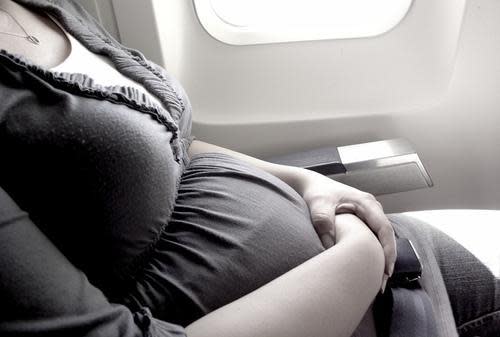What Happens If You Go Into Labor On A Plane?

If you go into labor on a plane, flight attendants can actually do very little to help you. (Photo: Mliu92/Flickr)
On Oct.7, a doctor from Los Angeles delivered a baby during a flight over the Pacific Ocean.
After departing from Taiwan, Dr. Angelica Zen was dozing off when flight attendants asked if there was a doctor on board to assist a woman with abdominal pain. Zen responded, and quickly found that the woman was actually in labor. Working with help from flight attendants, Zen delivered the baby just as the China Air flight made an emergency landing in Alaska. The mother and newborn baby girl were taken to a nearby hospital, and the rest of the passengers continued on to Los Angeles with one heck of a story to tell.
But this isn’t the first time someone has gone into labor on a plane. In March, a woman’s water broke mid-flight and the American Airlines flight was diverted. And back in January, a woman gave birth to a healthy baby girl during a transatlantic flight from Jordan to New York’s JFK.
According to news reports, a nurse and a doctor aboard the plane helped deliver the baby mid-flight, and mother and daughter were handed over to medical staff on the ground upon landing and taken to a nearby hospital.
In December a Southwest flight from San Francisco to Phoenix was diverted to LAX after a passenger went into labor midflight. And again the baby was born onboard the plane.
In-flight labor is really more common than you would think.
MedLink’s Global Response Centre in Phoenix, which provides assistance via phone to airline staff dealing with in-flight medical events, dealt with 27 in-flight labors from 2006 to 2008.
Related: Single and Pregnant: Why I Took a Solo Babymoon
But in relative terms, that is only a very small portion of the 55,000 total medical emergencies the service was involved in over the same period. So what happens if you go into labor at 30,000 feet?
First, there is actually very little protocol for flight attendants to deal with a woman going into labor onboard.

Airlines advise against flying beyond the 36-week mark, but they can’t actually prevent you from doing so. (Photo: Thinkstock)
Airlines set individual regulations about how late into the pregnancy a woman is allowed to travel (usually 36 weeks) but unfortunately, the choice to fly is at the discretion of the passenger, who has the ability to conceal the stage of her pregnancy.
“Flight attendants are NOT trained to deliver babies,” says veteran flight attendant and author James Wysong. “We are required to watch an antiquated black-and-white video on the birthing process in case a baby happens to arrive aboard one of our flights.”
“The only thing I learned from the training was to make a call for a medical professional to come forward and hope that one would,” Wysong continued.

“Is there a doctor onboard?” (Photo: Jupiterimages)
This is usually the first the step in the process, inquiring about medical professionals onboard.
Flight attendants deal with these emergencies on a case-by-case basis depending on the circumstances. How long is the flight? How long into the flight are they? Is there a doctor or nurse on board? Are their complications with the pregnancy or birth? Upon discovering the labor in progress, staff on-board are required to make a judgment call about whether an emergency landing is required.
“Unless the aircraft is just leaving or arriving, an in-flight birth almost always would result in a medical diversion because the cabin crew and medical volunteers cannot be sure of the health status of the newborn,” reveals Paulo Alves, MD, vice president, aviation and maritime health.
But that doesn’t happen in all cases.
Luckily, flight attendants have access to MedAire’s Global Response Centre, who they can call for assistance and advice on dealing with the emergency midflight. Trained professionals can then talk the staff through, step-by-step, how to treat the patient and if necessary, deliver the baby.
But on a packed flight, where can you actually go to give birth? Again, it depends on the specific circumstances.
Related: How to Survive Burning Man…While Pregnant

There’s not a ton of options for where to deliver a baby on an airplane. (Photo: Christopher Doyle/Flickr)
According to a Flightsaftey.org study into in-flight child-birth, one of the first cabin safety issues is where a passenger in labor can be accommodated.
“Flight attendants may have to weigh the safety risks of temporarily foregoing the maximum protection of passenger seats and a seat belt, to position the woman on the floor of a galley, an action best avoided if another solution is workable.” So if the only open space available is in the plane kitchen, then that is where the birth will occur.
Another issue with in-flight birth, is the question of the baby’s citizenship.
The United Nations states that a child born mid-flight is a citizen of the country where the airline is registered. This is due to admiralty law which says that if the vessel you are traveling on is French, you are technically on French soil.
One perk to going into labor during a flight is that some airlines have even been known to provide lifetime free air travel to a baby born on board one of their planes.
But either way, being born tens of thousands of feet in the air will make for a great story.
Let Yahoo Travel inspire you every day. Hang out with us on Facebook, Twitter, Instagram, and Pinterest.
